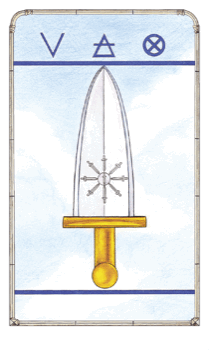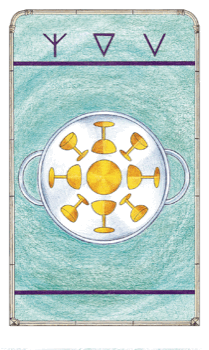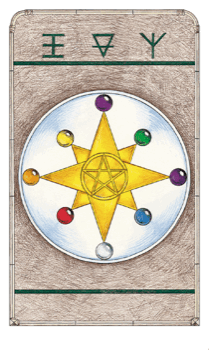 Send
comments about this page
Send
comments about this page Last update: 6 Sep 2022
So also the Pythagoreans call the Decad "Universe" because it arranges all things; "Heaven" because it contains all things; "All" because it is greater than all numbers and all numbers return to it; "Fate" because it is the source and boundary of the elementary numbers, and generates in order those beyond itself; "Eternity" because it encompasses whatever happens and is everlasting; and "Power" because it controls all the other numbers and strengthens everything. It is the Number of the Cosmos and the Foundation of Creation.
They also call the Decad "All-fulfiller" because it brings all things to fulfillment, carrying them to their natural ends; it finishes tasks of all kinds. Therefore the Achaeans laid siege to Troy for nine years, and it fell in the tenth; so also Odysseus wandered for nine years and returned in the tenth. The Decad comprises the Monad and the Ennead, which are the center and circumference of the Circle, which represents Well-rounded Wholeness.
The Holy Tetraktys (1 + 2 + 3 + 4 = 10) symbolizes the All-embracing Decad, for the Monad is the font of existence; the Dyad is the principle of division, which creates all forms; the Triad is the threefold activity of the psyche; and the Tetrad is the fourfold nature of matter. The Tetraktys is equal on every side, balanced around its center, and symmetric in all six directions; it shows the perfection of the Decad in its one center, three sides and six directions (10 = 1 + 3 + 6).
The Pythagoreans also call the Decad "Necessity" because it corresponds to the outermost rim of the heavens, the Prime Mover which drives the inner spheres, and so also the Decad encompasses all things, causing them to change by mixing and separating the elements. They also call it "Atlas" for, as He holds the pillars of the heavens, so the Decad is the Cosmic Spindle that holds together the heavenly spheres and turns them in their places.
The Decad is a return to the Monad which brings with it the history of the intervening numbers, and so it is called "Memory" and named after the Muse Mnemosyne, for memory carries into the past the present, which incorporates all that has happened since. It is the Platonic Anamnesis (Recollection), the return to primordial wholeness, but consciously, for the Monad was unconsciously integral whereas the Decad integrates the characters of the other numbers.
The Decad is the Lapis Philosophorum (Philosophers' Stone), the beginning and end of the alchemical process. As such it is called Elixer Vitae (Elixer of Life) and Filius Philosophorum (Son of the Philosophers). It is called Hermaphroditus because it balances the female, which is even, with the male, which is odd (10 = 2 X 5).
Indeed, the Pythagoreans say the Decad is Perfection because it brings about balance, for it is the first number to balance the primes (1, 2, 3, 5, 7) and the composites (4, 6, 8, 9, 10). It therefore represents the first stage at which complete balance is achieved, and it incorporates the harmonies of all the preceding numbers. It is a symbol of concord, love, peace and the Pythagoreans call it Trust.
In summary, the Decad is the perfect realization of the preceding numbers, and reintegrates the progression into a new and more refined whole, which is perfect in its balance and internal harmony. It becomes the prime mover, organizing all change and bringing it to its fulfillment according to necessity.




The unconscious force of the Ace of Wands has been replaced by the conscious force of the Dix. It is now a potent instrument that must be used circumspectly, or it will become self-defeating, and the Dix will be no better than the Ace. Mastery of Will and Spirit.
Image: A large keraunos (thunderbolt), similar to the Ace of Wands, but its round center is the sigil of the Nine of Wands (the symbol of Mercury surrounded by a double cross of thursoi and keraunoi). Rays emanate from it across a glowing background.
Commentary: The image represents the enfolding of the Decad back into Unity, 10 = 1+0 = 1. The Decad sends out its force as did the Ace, but whereas there was chaotic power at the center of the keraunos of the Ace, the keraunos of the Ten has at its center all the differentiated structure of the Decad. The rays and glowing background represent a much more disciplined manifestation of power.
(N.B.: I think the Pythagorean interpretation of the Decad requires a more positive reading of the Dix of Swords than is usual.)
Image: A large sword with a golden hilt and silver blade, on which is engraved the sigil of the Nine of Swords (dagger medallion surrounded by a double cross of inward pointing swords). A background of white clouds on a bright blue sky.
Commentary: The enfoldment of the Decad into the Monad. The outer sword represents the intellectual excitement of new beginnings, but the sigil contained within represents a base of deep understanding. The wisdom is contained in the silver (female) part of the sword, but deployed through the golden (male) part. As in the Ace, the background shows that "the sky's the limit."
Image: A two-handled silver kylix (shallow wine cup), viewed from the top, in the bottom of which can be seen the golden sigil of the Nine of Cups. The background is blue-green.
Commentary: The Decad contained in the Monad; instead of being filled with chaotic emotion, the cup has within it the developed structure of the Decad. The capacious vessel is silver (female), the structure is golden (male). The blue-green background represent the universal sea of feeling by which all relationships are nourished.
Image: A silver disk on which appears the golden sigil of the Nine of Pentacles (the complete eight-rayed star); the points of the star terminate in round gems (white, red, orange, yellow, purple, green, violet, blue, clockwise from the bottom). A brown, earth background.
Commentary: The structure of accomplishment (gold) within the matrix that sustains it (silver). Despite the splendor of the gold and silver pentacle, the earth, brown background reminds us of the humble sources of all true accomplishment. We should be proud of our feet of clay....
 Send
comments about this page
Send
comments about this page
Last update:
6 Sep 2022